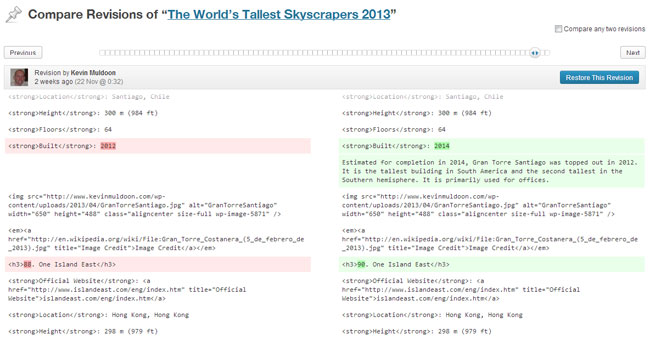The WordPress revision system is worth its weight in gold. By default, WordPress will save an unlimited number of revisions for your posts and pages. A revision will be saved every time you save or publish a post. Revisions are also saved regularly automatically. This is known as autosave. I have no doubt you have seen WordPress flash a message in your post editor that your article is being autosaved. It is a discrete feature that works in the background.
Revisions can save your ass in many situations as it allows you to go back to any point and view what was there before. You can also restore any previous revision and define it as the latest draft. This is useful, though it is not always practical; particularly if you have worked a lot on an article. For example, I have had articles that took weeks to prepare. Due to this, they had dozens of revisions stored. I have even written articles that had more than one hundred revisions.

An excessive number of revisions can slow down your website. An article with fifty revisions will take up as much space in your database as fifty articles which have one draft each. So it is easy to see how quickly revisions can increase the size of your database.
To address this, many WordPress users limit the number of revisions by adding the following code to their wp-config.php file (x should be changed to the maximum number of revisions you want to store):
define( 'WP_POST_REVISIONS', X );
It does raise the question: How many revisions should you save for an article?
I feel that at least one revision has to be saved, however two or three post revisions would give you a little more flexibility.
Many WordPress users have decided to disable post revisions altogether. Some WordPress hosting companies are also enforcing this rule for customers.
Whilst I do understand why this decision is made, I do not feel it is practical as it means your work can easily be lost. Unfortunately, that is what happened to me yesterday. I was working on a very long article for my friends at WP Hub. Whilst writing the article, the page started reloading as I accidentally clicked on the tab to reload (in my defence, this was due to a bug on my computer that re-enables the touchpad randomly) . Clicking on the back button went back to the last draft that was saved, but WP Hub has disabled revisions. Due to this, there were not any autosaves.

I lost about thirty minutes of work. If revisions had been enabled, the autosave feature would have updated the last draft a few minutes earlier. I was lucky I had saved the post thirty minutes beforehand. There have been times in the past when I have not saved the post I was working on for an hour or so. Those of you who have lost a lot of work in this manner know frustrating it can be to go back and rewrite an article after losing it.
Disabling revisions is enticing. It greatly reduces the size of your database, which in turn improves the speed of your website. However, I hope you do not forget about the benefits of using the WordPress revision system. It was developed for a reason. You may not use it every day, but when you do need it, it pays to have the option of reverting to an autosave. That is why I recommend enabling at least one revision for your posts and pages.
Thanks for reading,
Kevin

